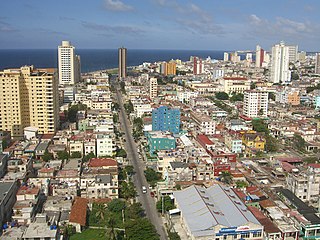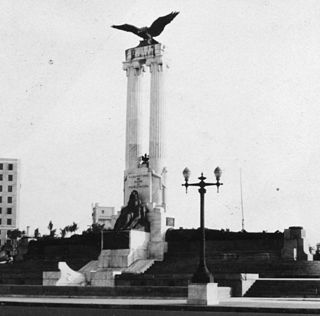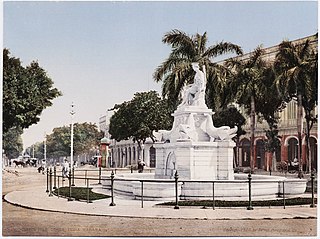
Havana is the capital and largest city of Cuba. The heart of the La Habana Province, Havana is the country's main port and commercial center. It is the most populous city, the largest by area, and the second largest metropolitan area in the Caribbean region. The population in 2002 was 2,137,847 inhabitants, and its area is 728.26 km2 (281.18 sq mi) for the capital city side and 8,475.57 km2 for the metropolitan zone.

Santa Clara is the capital city of the Cuban province of Villa Clara. It is centrally located in the province and Cuba. Santa Clara is the fifth-most populous Cuban city, with a population of nearly 245,959.

Vedado is a central business district and urban neighborhood in the city of Havana, Cuba. Bordered on the east by Calzada de Infanta and Central Havana, and on the west by the Alemendares River and Miramar / Playa district, Vedado is a more modern part of the city than the areas to the east, developed in the first half of the 20th century, during the Republic period. In 2016 it was described by one commentator as the city's "most affluent" section. The main street running east to west is Calle 23, also known as "La Rampa". The northern edge of the district is the waterfront seawall known as the Malecón, a famous and popular place for social gatherings in the city. The area popularly referred to as 'Vedado' consists of the wards of Vedado, Rampa, Vedado-Malecón and Carmelo, all in the municipality of Plaza de la Revolución.

Old Havana is the city-center (downtown) and one of the 15 municipalities forming Havana, Cuba. It has the second highest population density in the city and contains the core of the original city of Havana. The positions of the original Havana city walls are the modern boundaries of Old Havana.

The National Capitol of Cuba, also known as Capitolio Nacional de La Habana, and often simply referred to as El Capitolio(The Capitol), is a public edifice in Havana, the capital of Cuba. The building was commissioned by Cuban president Gerardo Machado and built from 1926 to 1929 under the direction of Eugenio Rayneri Piedra. It is located on the Paseo del Prado, Dragones, Industria, and San José streets in the exact center of Havana.
Same-sex marriage has been legal in Cuba since 27 September 2022 after a majority of voters approved the legalization of same-sex marriage in a referendum two days prior. The Constitution of Cuba prohibited same-sex marriage until 2019, and in May 2019 the government announced plans to legalize same-sex marriage. A draft family code containing provisions allowing same-sex couples to marry and adopt was approved by the National Assembly of People's Power on 21 December 2021. The text was under public consultation until 6 June 2022, and was approved by the Assembly on 22 July 2022. The measure was approved by two-thirds of voters in a referendum held on 25 September 2022. President Miguel Díaz-Canel signed the new family code into law on 26 September, and it took effect upon publication in the Official Gazette the following day.

Havana was founded in the sixteenth century displacing Santiago de Cuba as the island's most important city when it became a major port for Atlantic shipping, particularly the Spanish treasure fleet.

The Monument to the Victims of the USS Maine was built in 1925 on the Malecón boulevard at the end of Línea Calle, in the Vedado neighborhood of Havana, Cuba.

Fuente de la India is a fountain by Giuseppe Gaggini in Havana, Cuba, at the south extreme of Paseo del Prado, about 100 m south of El Capitolio, between Monte and Dragones Streets. The figure represents the Indian woman "Habana" in whose honor Havana was named.
The following is a timeline of the history of Havana, Cuba.

Miguel Díaz-Canel Bermúdez is a Cuban politician and engineer who is the 8th and current First Secretary of the Communist Party of Cuba since 2021, and as well as the 17th President of Cuba since 2019. As First Secretary, he is the most powerful person in the Cuban government. Díaz-Canel succeeds the brothers Fidel and Raúl Castro, making him the first non-Castro leader of Cuba since the revolution, and as well as the first non-Castro head of state since 1976.

The First Secretary of the Central Committee of the Communist Party of Cuba is the top leader of Cuba. The First Secretary is the highest office within the Communist Party of Cuba as well as ranking first in the Politburo, the highest decision-making body in Cuba, which makes the office holder the most powerful person in the Cuban government. In communist states the First or General Secretary of the Communist Party is typically the de facto leader of the country and a more powerful position than state offices such as President or Prime Minister, when those positions are held by different individuals.

The nations of Cuba and Mexico have had uninterrupted diplomatic relations since their establishment in 1902. Both nations are members of the Association of Caribbean States, Community of Latin American and Caribbean States, Latin American Integration Association, Organization of Ibero-American States, and the United Nations.

Cubana de Aviación Flight 972 was a scheduled domestic flight operated by Mexican charter airline Global Air on behalf of Cubana de Aviación, from José Martí International Airport, Havana, Cuba, to Frank País Airport in Holguín, Cuba. On 18 May 2018, the 39-year-old Boeing 737-201 Adv. operating the route crashed shortly after takeoff, near Santiago de las Vegas, 19 kilometres from Havana city centre. Of those on board, 112 died and one passenger survived with critical injuries. There were initially four survivors, but three of them later died at a local hospital. Most of the passengers on board were Cuban nationals, although the crew was entirely Mexican.
Events in the year 2020 in Cuba.

A series of protests against the Cuban government and the Communist Party of Cuba began on 11 July 2021, triggered by a shortage of food and medicine and the government's response to the resurgent COVID-19 pandemic in Cuba. The protests were the largest anti-government demonstrations since the Maleconazo in 1994. Protesters' motivations included resentment at the Cuban government's authoritarianism and curbs on civil liberties, the government's COVID-19 pandemic lockdown rules, the government's failure to follow through on promised economic and political reforms. Protesters were also angered by the poor state of the Cuban economy. Cuban dissidents have placed the responsibility on the government's economic policies and human rights abuses.

On the night of 27 January 2019, at 20:20 CST, an unusually violent and destructive tornado ripped through the Cuban capital Havana. The EF4 tornado toppled trees and utility poles, destroyed cars and sent debris flying as it passed through the city. According to the Cuban Institute of Meteorology, the tornado was produced by a cold front that struck the nation's north coast, but "there were no indications of the anticipated existence of any cloud that fulfilled the characteristics of a classic supercell, nor a minisupercell, and that would explain the development of the intense tornado". At least eight people died and more than 190 were injured.

The Hotel Saratoga was a historic hotel located on the Paseo del Prado, in Old Havana near the Fuente de la India. Built in 1880 as a warehouse, it was remodeled into a hotel in 1933. It was further remodeled in 2005 and reopened as a luxury hotel. The hotel was largely destroyed by a gas explosion on 6 May 2022, which killed forty-seven people.
This article covers events in the year 2022 in Cuba.















